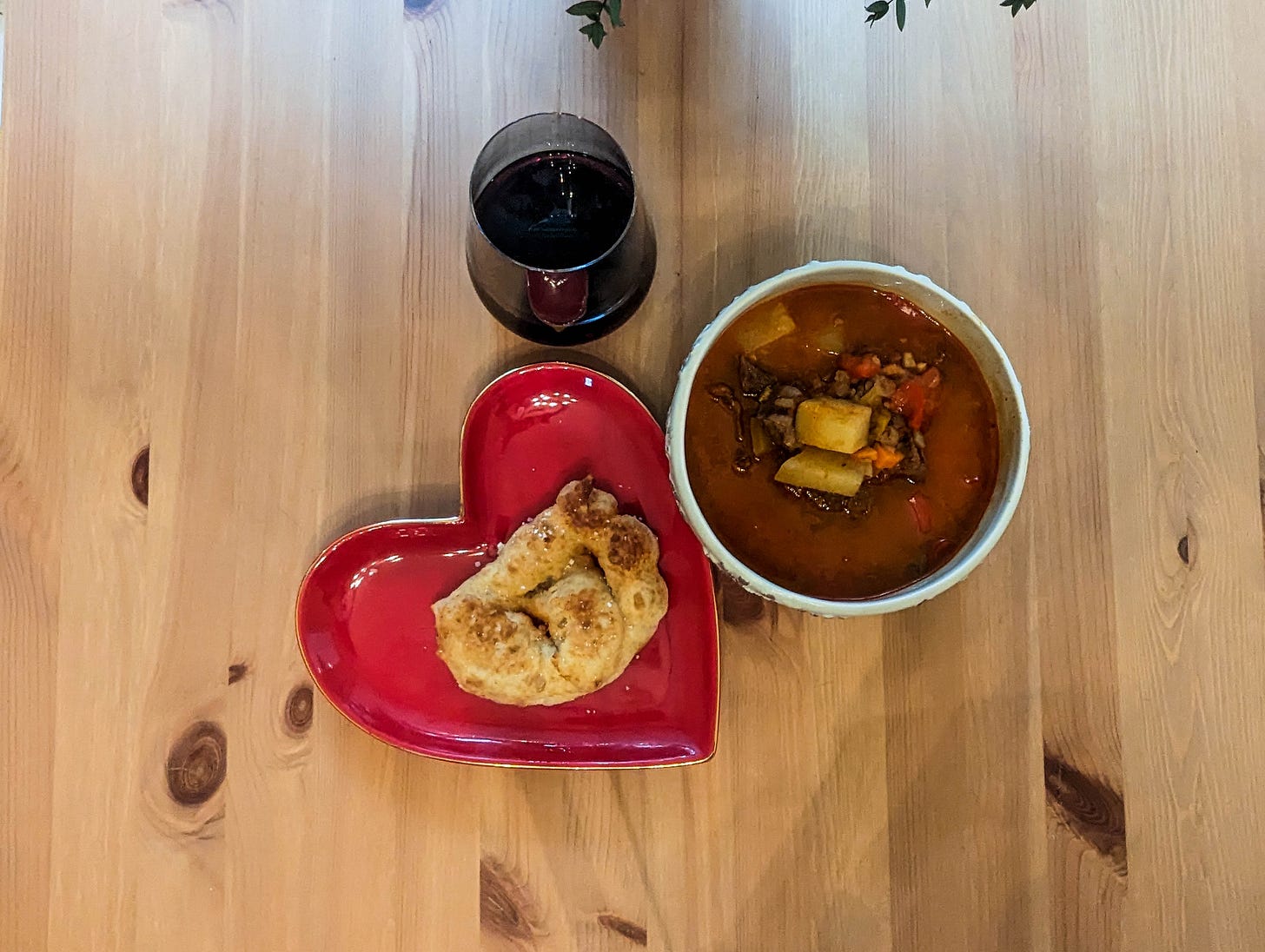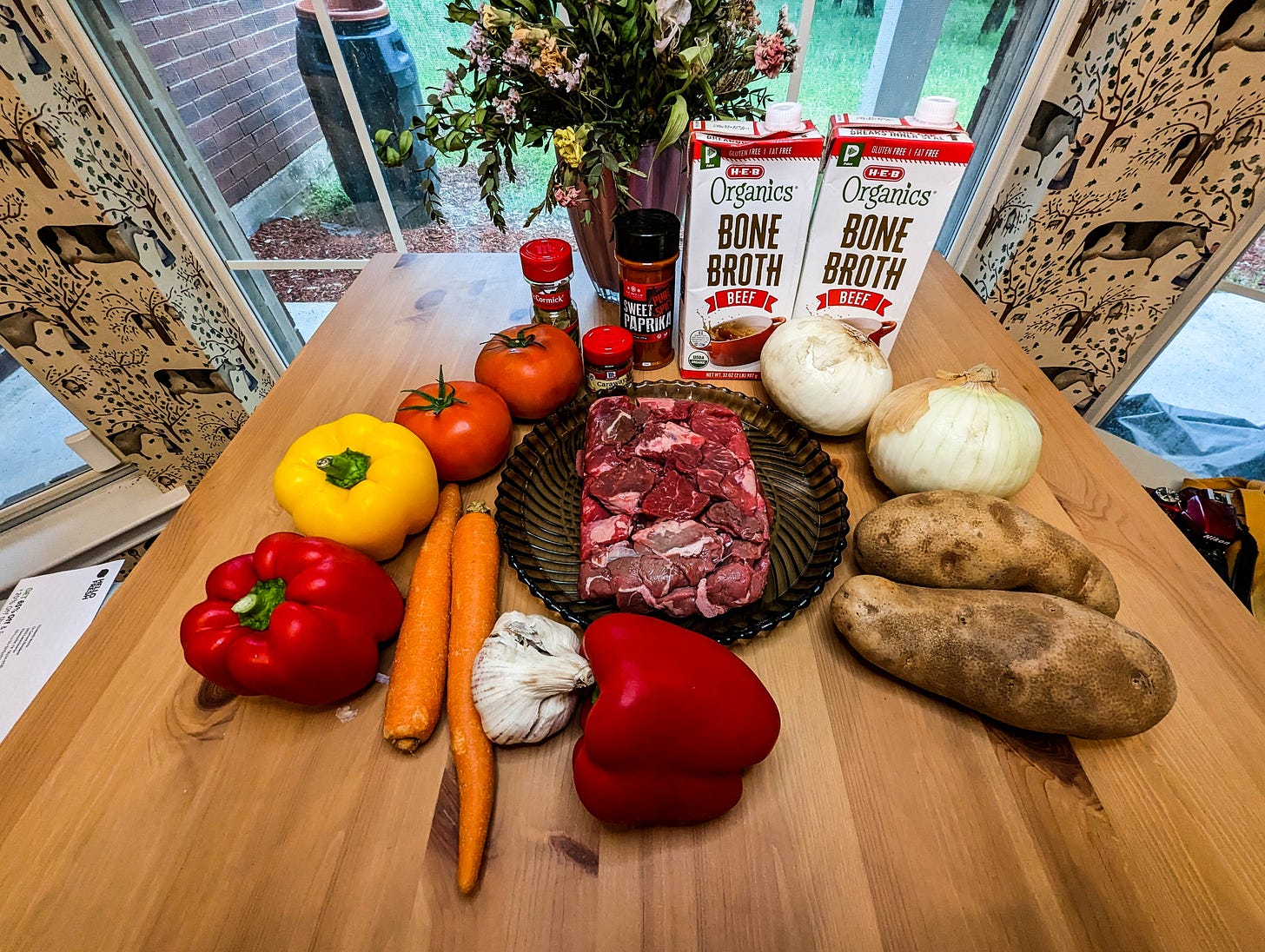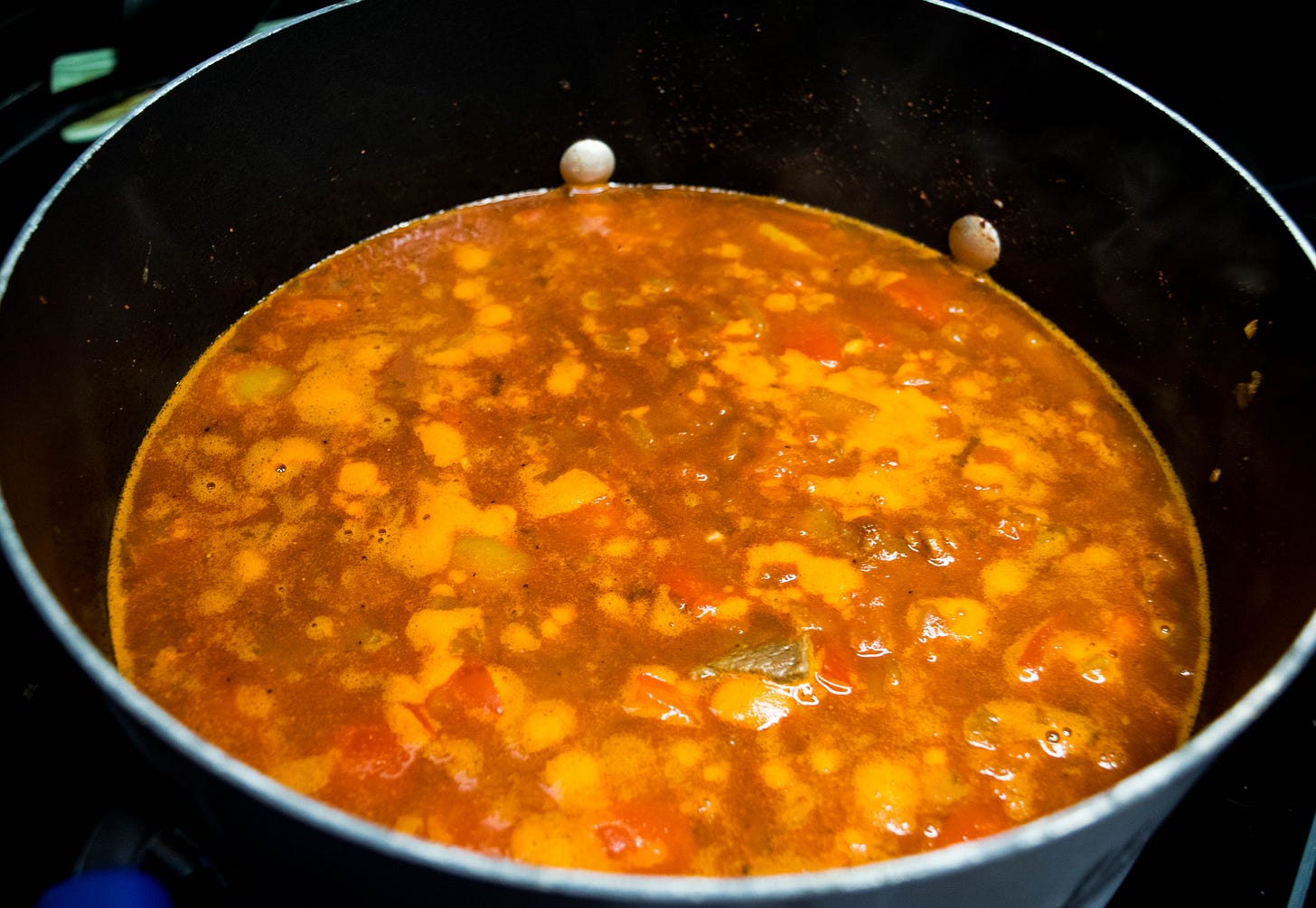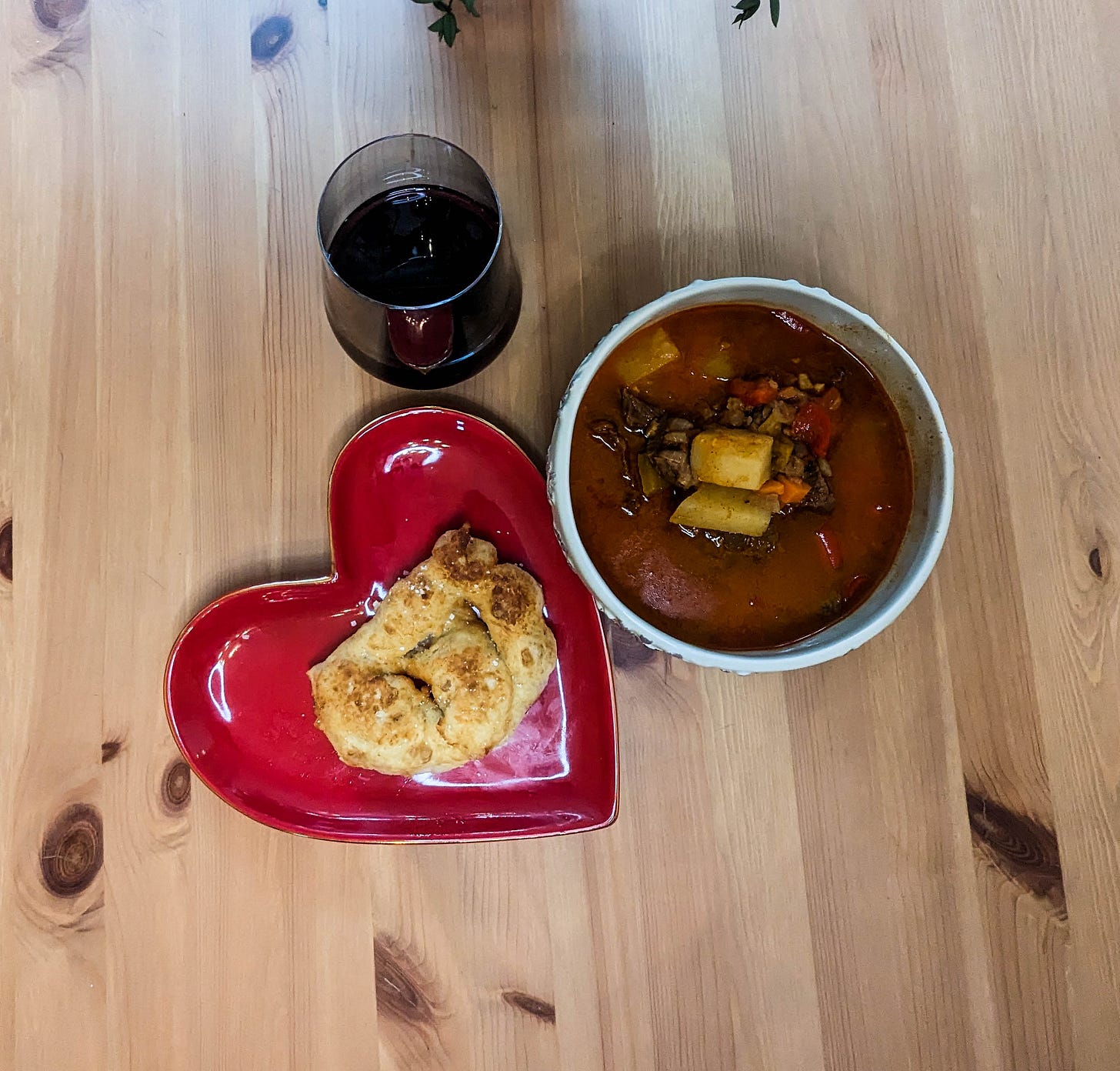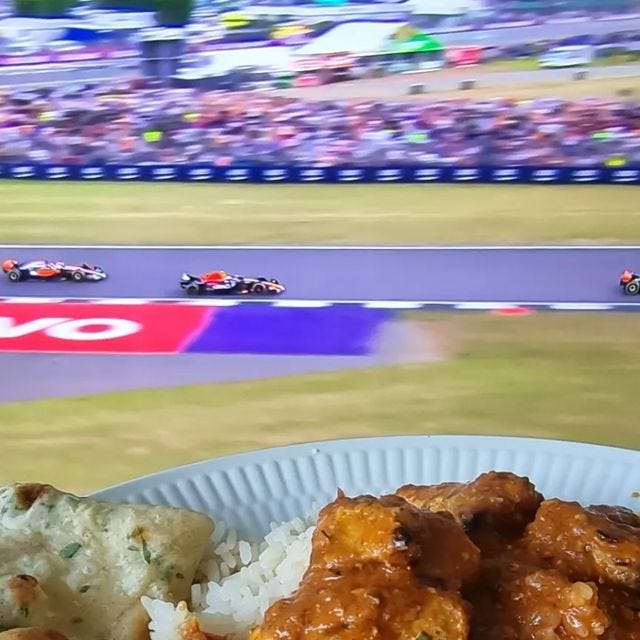Goulash Goes Great with the Hungarian Grand Prix
Welcome to Grand Prix Gastronomy! This week, I’m cooking goulash, the national dish of Hungary.
This project is pretty simple. As a complement to each race weekend, I’ll be cooking the national dish of that race’s host country and sharing information about the process and that dish’s history along the way in an effort to grow more deeply immersed in the local culture from my own home.
Thanks for reading Grand Prix Gastronomy! Subscribe for free to receive new posts and support my work.
What Is Goulash?
I can’t say that the word “goulash" brings to mind many fond memories. Until Grand Prix Gastronomy, I’d never actually consumed the dish, but that was because my dad used to recount a story about the goulash he got from his school cafeteria as a child, which was essentially some noodles topped with unspiced ground beef and stewed, quartered tomatoes. The whole mental image was so unappetizing that I never once considered goulash to be a food I’d deign to eat — even as I got older and realized that the Americanized school lunch bastardization was nowhere near the real thing.
But CNN claims that it’s Hungary’s national dish (and, honestly, I don’t know that I would be able to name many other Hungarian foods), and so I would be taking to the kitchen to put together this feast — despite the fact that Wikipedia counters that claim by saying it isn’t eaten very often.
In Hungarian, goulash is written gulyás and is actually pronounced goo-yash. It’s a soup-y, stew-y main dish loaded with beef, vegetables, and a fair amount of paprika to make for a hearty meal beloved by shepherds of a bygone era. It’s one of those dishes that just gets better and better the longer you let it simmer.
This Week's Recipe
This week, I opted for a recipe from The Daring Gourmet, largely because it really emphasizes the history of the dish and breaks down the misconceptions that a lot of Americans have about it. Beyond anything else, you're looking for a recipe that asks for a formidable shitton of Hungarian paprika — and I highly recommend you seek out some of good quality. The final product will be worth the little extra price, and if you add more than the recipe calls for, well, you're on the right track.
I had high aspirations for my cooking this week and had originally planned to whip up some stuffed cabbage rolls, which… ultimately didn't happen. However, I highly recommend you try cooking lángos! It's a fried Hungarian bread that is literally so delicious.
Cooking Goulash
Cooking the goulash was really simple, and most of your effort is going to be out of the way pretty quickly. I started by cutting up all my veggies — onions, garlic, bell peppers, tomatoes, carrots, and potatoes — before everything else. You'll want to cook your onions down first in a large soup pot, then brown your beef. Add in the garlic, peppers, and tomatoes, cook for a few minutes, and then remove the pot from the heat to stir in the paprika. Pop it back on the heat, add your broth and bay leaf, and then let that bad boy simmer.
This is one of those recipes I think I'd have enjoyed more if I had let it simmer for longer, but some days simply call for wrapping up dinner as quickly as possible, and this was one of those days. Whatever route you go, just add in your potatoes and carrots about 30-40 minutes before you want to serve the goulash, which will give them plenty of time to soften.
The lángos recipe was also fairly simple because it featured instant yeast. All you have to do is mix together warm mashed potato, sugar, flour, oil, salt, and milk, knead it for a while, and then let it rise for an hour. Once the dough has doubled in size, divide it into four to eight equal pieces, roll those pieces into a ball, and let them rise for 20 more minutes. While it finishes the rise, heat up your oil. Before you drop the lángos in, you'll flatten out each ball, make a few slits in the center with a knife, and then pop it into the hot oil. The entire piece of bread should take less than five minutes to cook up.
To serve, I spooned my goulash into a massive bowl and dipped my lángos in. The meal was accompanied by a montepulciano wine, which was a great combination. The wine is a little smoky and herby, which makes a solid contrast with the highly spiced goulash.
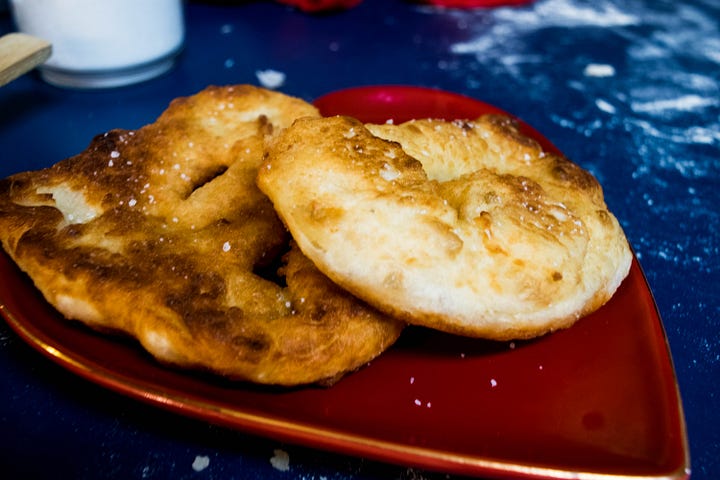
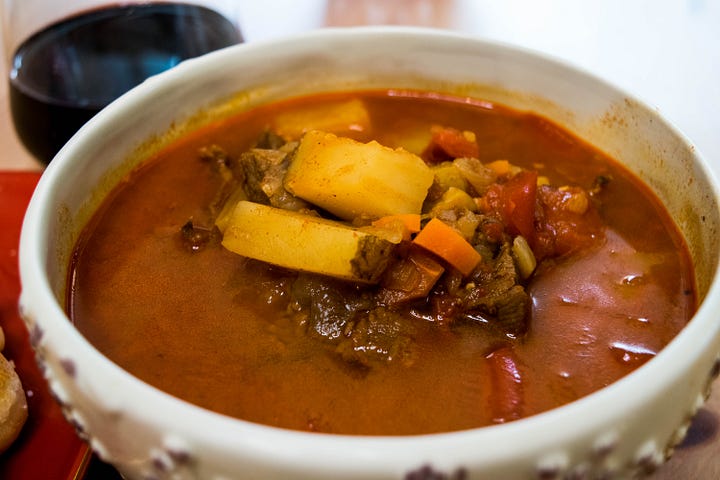
So, What's the Verdict?
I'm sure you all might have guessed by now, but my perspective of goulash has changed dramatically as a result of cooking Hungary's national dish the proper way, not the cursèd American way. That being said, though, I'm still fairly lukewarm about it! It was a tasty soup/stew, but I don't know that it left a deep enough impression on me that I'd be clamoring to make it again. It was good, but I don't think I'd call it great. I think there's a good chance I'll be using up the rest of my paprika to make something like paprikash instead.
But the lángos, though. My god, the lángos! I'm still thinking — nay, I am still dreaming — about that fried bread. I think it would take a truly herculean effort to make a fried bread unpalatable, but I do think I was particularly excited by the results of this side because it was the first time I left my dough really moist. I know, I know, you're supposed to leave many doughs soft and squishy and well hydrated, but I've always panicked at the though of a sticky dough and added too much flour. This time I just closed my eyes and told myself to trust the process, and it worked out so well that I'm annoyed at myself for not trusting my baking recipes more regularly.
(I'll also admit here that I split the dough in half so that, after frying, I'd have both sweet and savory lángos. I covered the sweet ones in cinnamon sugar, and the result was kind of like an elephant ear or a beaver tail. When I fried the savory ones, I removed them from the oil and rubbed them with a garlic clove, then sprinkled them with crunchy kosher salt. Impeccable combo, I highly recommend.)
Hungary: you've left me perplexed, but I'm thankful this project got me experimenting with new cuisines. The goulash may not have bowled me over, but as I poke around for new recipes to use up the rest of my paprika, I'm finding plenty of recipes that I think I'll enjoy even more.
Let's Chat! How Far Do I Cook Ahead?
Last week, I think I surprised a few people, and I didn't mean to! I mentioned that I was cooking up the GPG dish for Monza several weeks ahead of time — and someone asked if that meant I wasn't actually making dishes during the race weekend itself. So, I thought I'd talk about my cooking ahead process!
Basically, I have to cook ahead. Every dish requires a day or more to cook, but I have to edit photos and video, write a Substack, and then get these posts out to y’all early in the week of said race in order to ensure you'll have enough time to stock up on supplies and ask any questions. At the very latest, I'll be cooking a dish the weekend before the race. And no, I don't cook the meal again during the weekend itself! I really do wish I could, but as Hot Motorsport Summer ramps up, there's not really a ton of time.
By the time August hits, I'll have been on the road for almost six weeks since the start of the F1 season. That's a lot of time where I'm not cooking, largely because I can't be cooking — I'm in a hotel in the throes of a work trip. Before I set off anywhere, I want to make sure that I've cooked ahead, so that my photos and video are ready to be posted on time.
But there's also one big concern that I finally encountered last week: What happens if I fuck up?
Now, when I set out to do this project, I assured myself that I would be sharing everything with you guys, even the screw-ups. So, if I cooked a dish that just went so poorly it was unsalvageable, I wanted you guys to see that. But I also wanted to make sure I'd have time for any do-overs. I would want you to see how to actually, properly make the meal.
As I cooked my Monza dish, though, I hit a stumbling block I didn't even foresee: My camera didn't save any of my videos of the cooking process. Over an hour of footage, and the bulk of what I'd be using to make my video later — gone.
I'll be honest, I kind of panicked. It sucks to put in that much work and then have nothing to show for it, especially with a dish as involved as the one I was making. But as I shared my panic with my husband, he asked a few crucial questions: “You don't have to start posting anything about Monza until, what? Late August? You have time to make it again.”
And, for as annoying as it is to have to go over that process again, he was right. I do have time to make the dish again. The only thing I'm missing is video footage of the on-the-stove portion of the meal, and the dish was so damn good that I already saved the recipe to make again. I just wasn't expecting to have to make it so soon.
So, that's the answer to why I cook so far ahead. Because I am occasionally a dunce!
And once again: I love all of my besties who go out of their way to cook GPG meals each week! You guys are the real ones!!!!
If you want to stay tuned…
Here are all the relevant links in one place, if you want to subscribe:
All Grand Prix Gastronomy-related content will be free — but if you want to drop me a donation on PayPal, that’s always welcome.
Next up: Belgium!
View draft history
Settings





